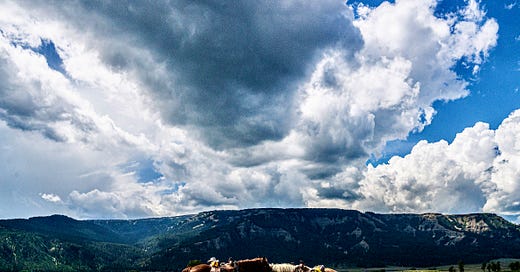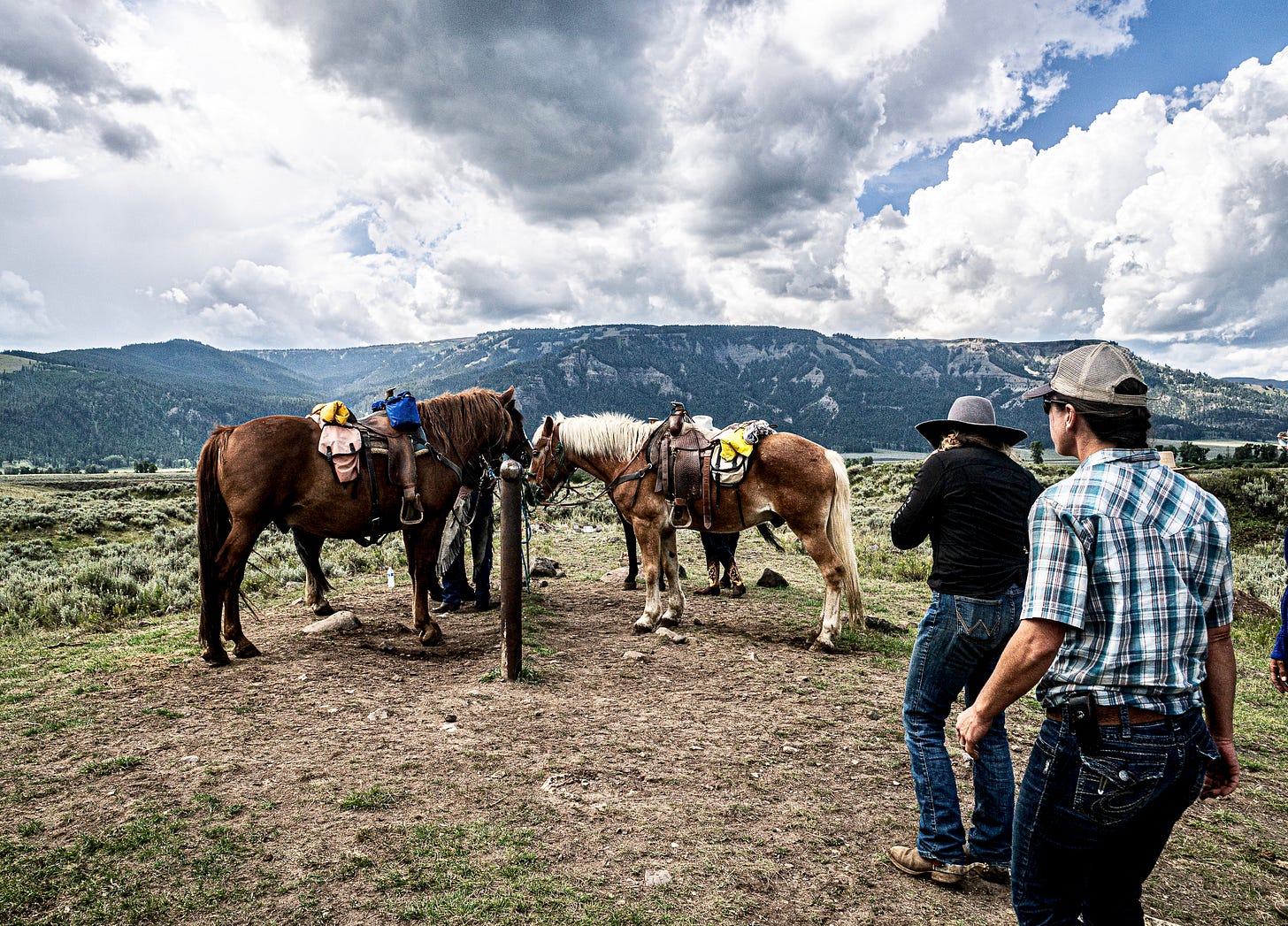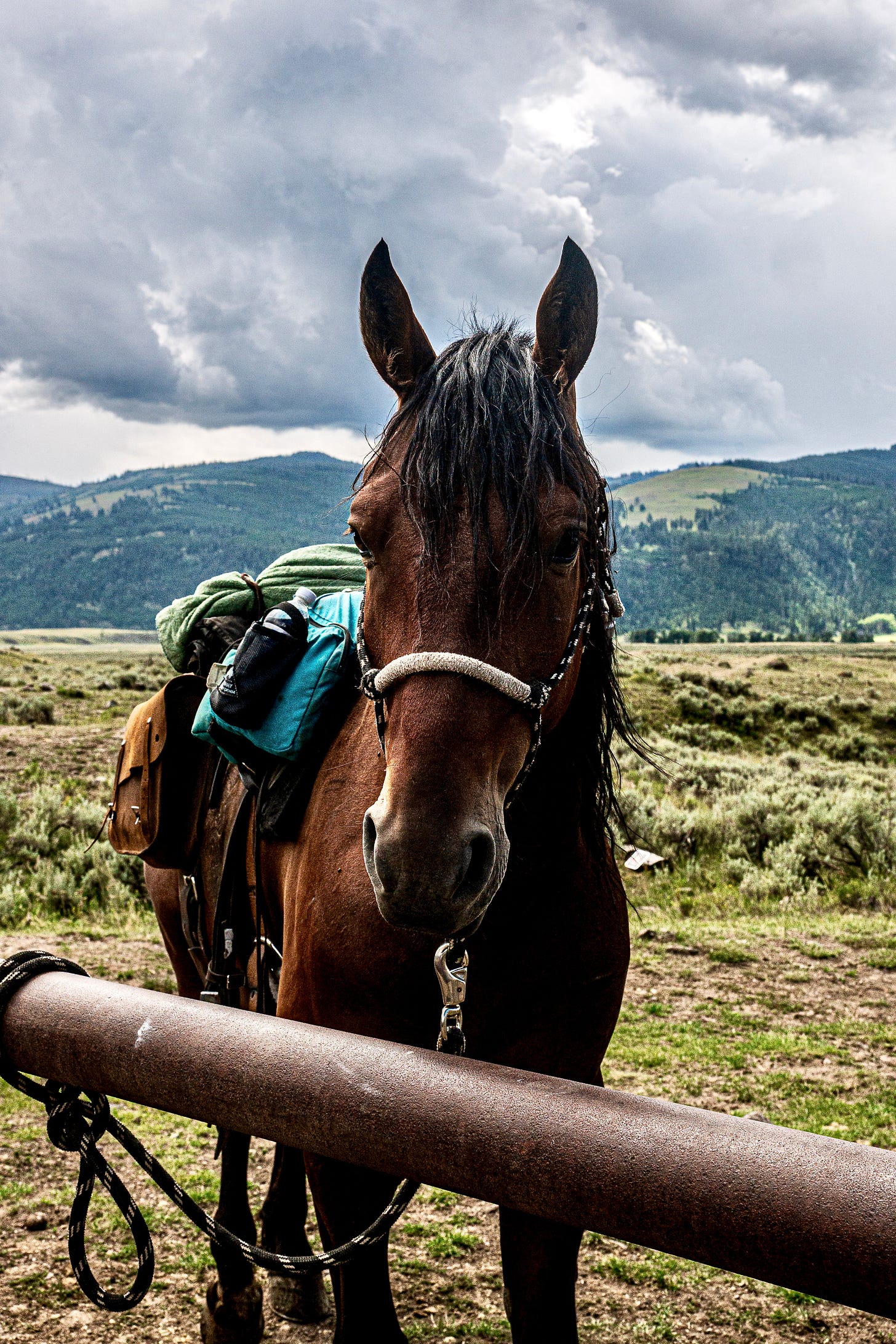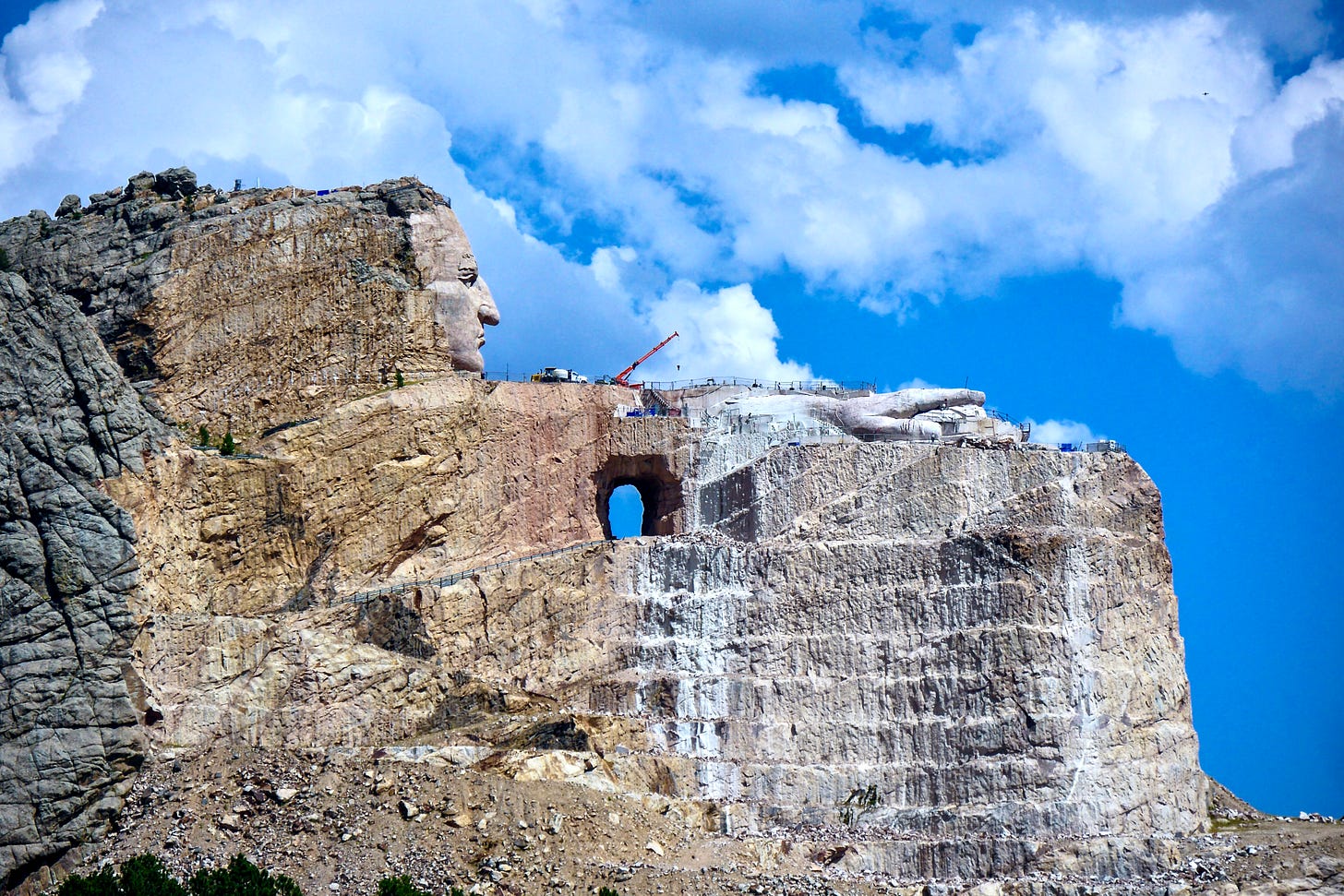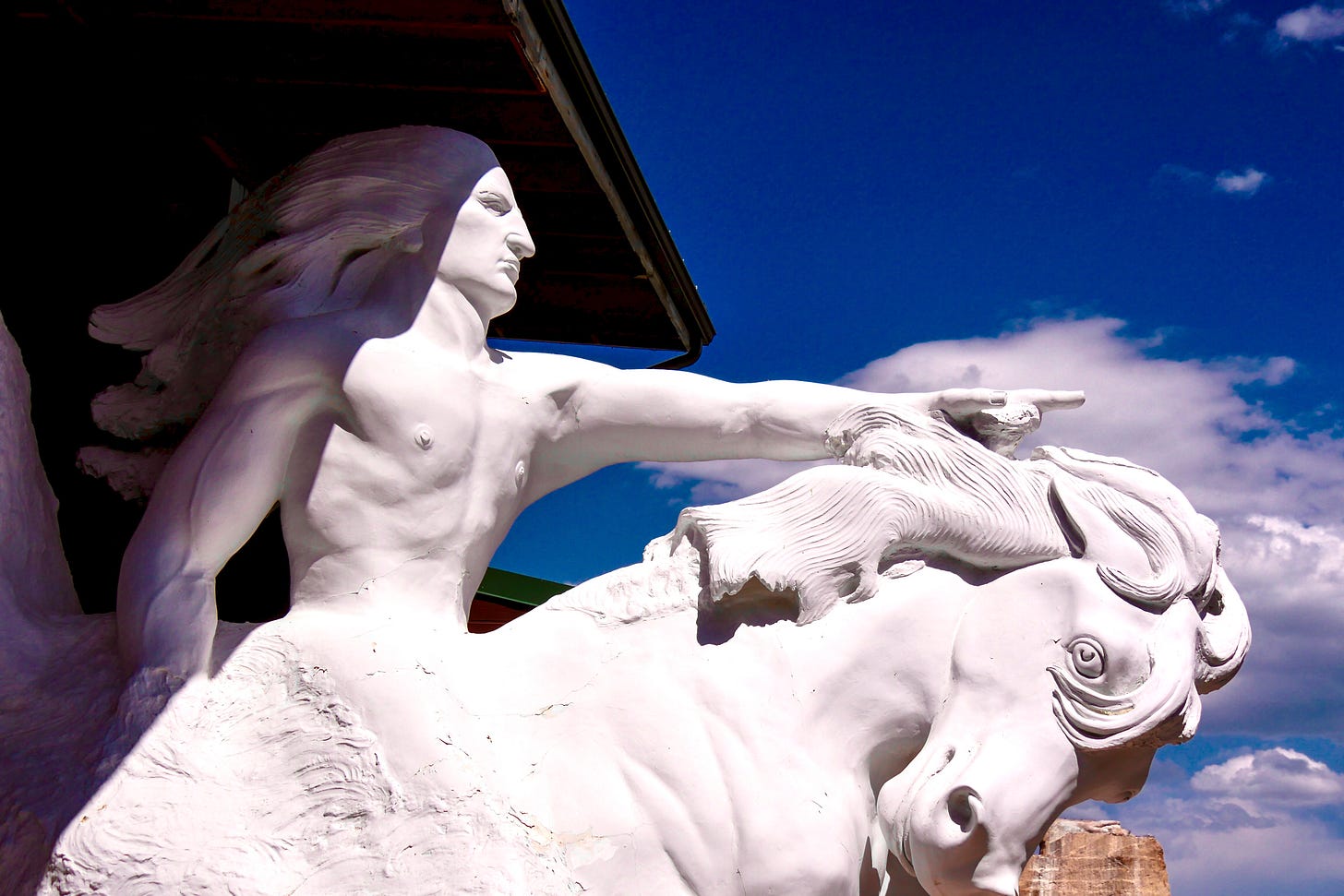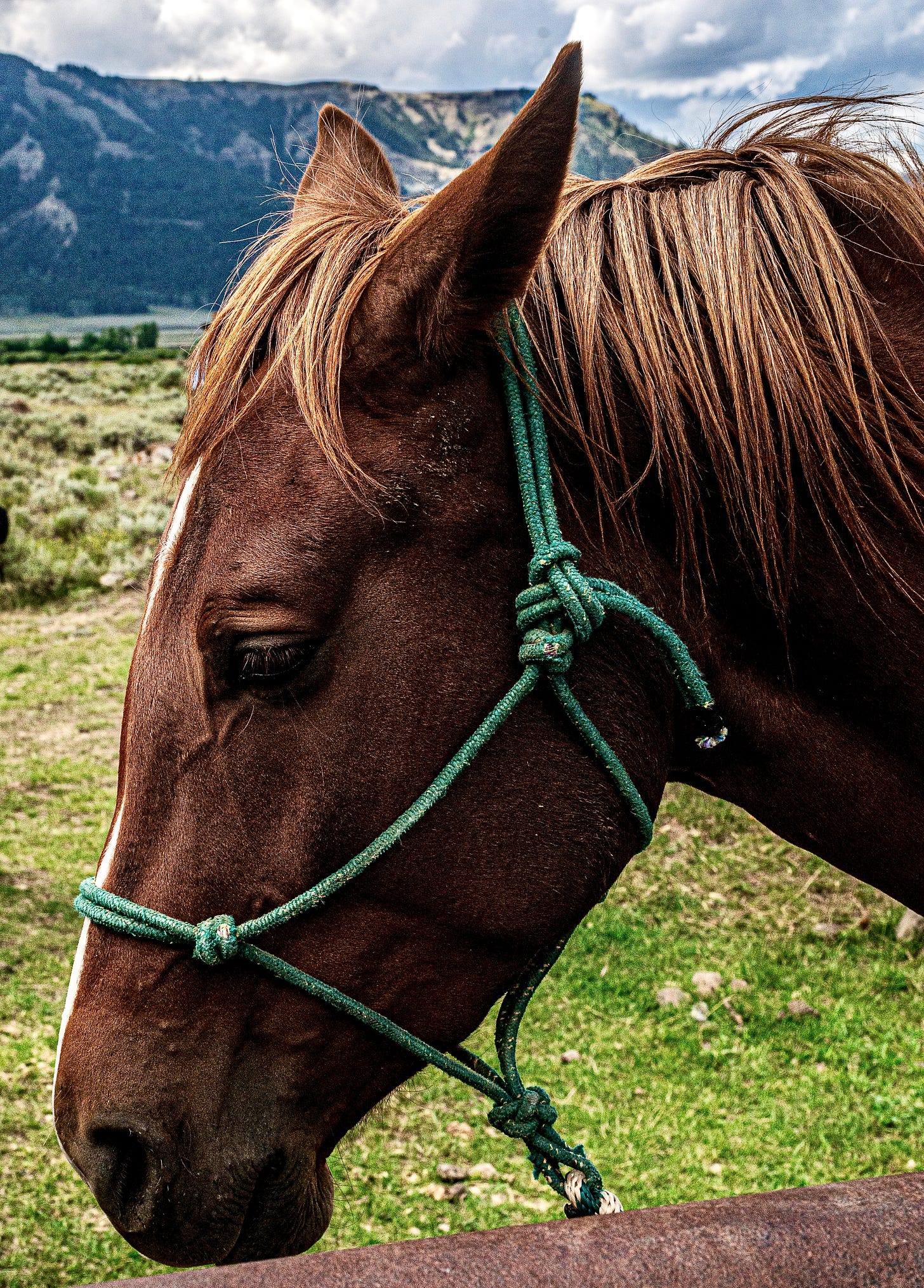Horses in Yellowstone “They will appear, may you behold them! A horse nation will appear, behold! Black Elk Speaks ~ John G Neihardt You stand tied to a rail tails swishing, hooves scuffing the dirt, saddles well worn. Your ancestors came from here, died out and then returned with Cortes, bringing empire. As I rounded the bend there you were against a backdrop of green wooded mountains. The fawn and tan rocky shoulders showing through the Douglas firs, under dark rising thunderheads. Your forebears escaped the yoke and ran mustang free on the plains, became the prize of the people. Yet you served the settlers faithfully and serve them still, bearing their way of life, without you no cowboys. Here in Yellowstone you bear these tourists into the landscape, spurs clinking, hats jauntily cocked. I walk up to one of you, touch your brown face and the black eyes meet mine, you nuzzle my hand. We made a covenant of freedom with you, our freedom for your indenture, your long servitude, and when we no longer needed your legs, we measured our vehicles in enumerations of your motive power. This picture is the West as it is sold, land of the free, home of the brave, but in your eyes, meeting mine, is another story, also told in the ancient bones and the great falls of the Yellowstone, that freedom is gained by mutuality. It may be that when Crazy Horse is mounted again over Dakota’s Black Hills we will accept that a covenant made with hearts like yours, beating round mine here, is the only way to save ourselves, our lives, by acting as if ‘the holy land is everywhere’.* * Attributed to the Lakota Holy Man - Black Elk
I am in the process of finishing a new collection of poetry with the working title ‘Where Do Dreams Come From?’ I am including reworkings of the Mid West poems I shared in the early days of this Anxious Poet’s Substack. In the process of editing them I found I had another poem in me. The photo at the head of this post was the spark that caught my imagination and began the process that led to this finished poem.
Tom and I, as many will remember, set off across the Mid West in August 2023 starting in Denver heading up through Wyoming stopping in Cheyenne, and Fort Laramie, then into the Badlands of South Dakota, staying in Rapid City. As we headed back towards Wyoming and the Yellowstone National Park we crossed the Black Hills and visited the Crazy Horse Memorial, more of which later. Having visited Sheridan and Cody - frontier towns in Wyoming we headed into the Yellowstone. On our first day we headed to the Lamar Valley where all the wildlife is reputed to roam.
You travel slowly in the park as the speed limit is 45 miles an hour and we paused at a look out point and right in our camera line was the view in the photo. I said to Tom that we were looking at an icon of a particular version of the USA, an image that somehow encapsulated the way the West was portrayed when I was watching Westerns in my youth. The tethered horses were waiting for a group of tourists to be led on a ride into the valley. They were all suited and booted as cowboys, complete with hats and spurs.
As the bustle went on around me my attention was completely taken with the four leggeds and not the two. They stood there in a state of patient readiness and as I approached them they let me pet them and spend time with them. So in recent weeks when I contemplated whether I had any other experiences to record for the American West Section of the new poetry book - the faces of those horses in that landscape came back to me.
I researched the genesis of horses and learned that the fathers and mothers of the horses we now have, originated in the USA and then died out. Their European antecedents returned with the conquistadors and flourished. Those that escaped into the wild bred and became the wild mustangs that feature in films like The Misfits, with Montgomery Clift, Clark Gable and Marilyn Monroe, directed by John Houston and written by Arthur Miller made in the year I was born. The wildness of these magnificent horses and their subjugation is part of the haunting theme of that movie. They also became the prize of the Native Americans and became part of a symbiotic relationship between indigenous human’s, horses and buffalo that thrived until the settlers wiped out the buffalo.
As I worked on the poem another image came back to me - that of the Crazy Horse Memorial that we visited on the same day as we went to Mount Rushmore to see the faces of the four presidents. I also started reading a book I had been interested in for years - ‘Black Elk Speaks’.
Black Elk Speaks is a 1932 book by John G. Neihardt, an American poet and writer, who relates the story of Black Elk, an Oglala Lakota medicine man. Black Elk spoke in Lakota and Black Elk's son, Ben Black Elk, who was present during the talks, translated his father's words into English. Neihardt made notes during these talks which he later used as the basis for his book.
Wikipedia
There is a powerful section in the book about Horses, a kind of apocalyptic liturgy and I quote some of it at the head of the poem, it is all in a chapter called the The Horse Dance. This idea of the horses gradually appearing took me back to the Crazy Horse Memorial that Tom and I visited.
As you can see the statue is far from finished. It was begun in 1948 by Henry Standing Bear and a sculptor named Korczak Ziolkowski. It is all funded by donations, unlike the four presidents at Mount Rushmore that had federal backing. It is envisaged to be 641 feet (195 m) long and 563 feet (172 m) high. The outstretched left arm will be 263 feet (80 m) long, the opening under arm 70 feet (21 m) wide and 100 feet (30 m) high, and the extended index finger 29 feet 6 inches (9 m) long.[1] The face of Crazy Horse, completed in 1998, is 87 feet 6 inches (26.7 m) high - by comparison, the heads of the four U.S. Presidents at Mount Rushmore are each 60 feet (18 m) high. Here is what it will look like.
The project is not without contention among the Native American communities but its audacity and scale are somehow a recalibrating of the balance if only in terms of the size of monuments. The quote under the maquette says
‘My lands are where my dead lie buried’ Crazy Horse 1877
As I wrote the poem I thought about the time when Crazy Horse’s mount emerges from the mountain. I said to Tom that he should go back when he is as old as I am now and I am dead and gone. So that I might be able to see the finished monument through his eyes. I also took to heart Black Elk’s statement.
‘The holy land is everywhere’ Black Elk
In response to ‘drill baby drill’ we hear a different message when we listen to the heart of the world speaking. Through the green earth and the four leggeds that surround us. We are invited into a covenant that could save all of us. As Joseph Marshall III, a Lakota biographer of Crazy Horse says:
“A humble person rarely stumbles, the old ones say, because such a person walks with face toward the Earth and can see the path ahead. On the other hand, the arrogant man who walks with his head high to bask in the glory of the moment will stumble often because he is more concerned with the moment than what lays ahead.”
― Joseph M. Marshall III, The Lakota Way: Stories and Lessons for Living

